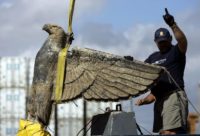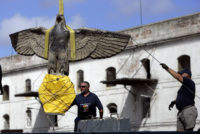 A court in Montevideo, Uruguay, has ruled that a Nazi eagle salvaged from a German warship in 2006 must be sold within 90 days after more than a decade in storage.
A court in Montevideo, Uruguay, has ruled that a Nazi eagle salvaged from a German warship in 2006 must be sold within 90 days after more than a decade in storage.
The German battleship Admiral Graf Spee came off the line in 1936, an example of the Nazi government’s rearmament program thumbing its nose at the restrictions of the Versailles Treaty. It was a hair shy of 10,000 tons in weight, the limit allowed per the terms of the post-World War I peace treasty, but it displaced over 16,000 tons making it well in excess of the limits. It saw limited action in the Spanish Civil War from 1936-1938. In 1939 it was sent to the South Atlantic two weeks before the official outbreak of hostilities to target Allied merchant shipping as soon as the war started.
The Admiral Graf Spee was fast, maneuverable and heavily armed. A combination that ensured that any French or British cruiser fast enough to give chase would be dangerously outgunned. In less than three months between September and December 1939, the battleship sank nine Anglo-French ships. It was engaged by the Royal Navy in the Battle of the River Plate off the coast of Uruguay on December 13th. This was the first naval battle of World War II and both sides took damage, the British more so than the German. Nonetheless, the Admiral Graf Spee had to limp into the neutral port of Montevideo with damage to the fuel system. Its captain Hans Langsdorff, deceived by British misinformation about phantom superior forces and concerned the ship’s cutting-edge technology would fall into Allied hands, scuttled the ship in the estuary of the River Plate.
The scuttled ship was not fully submerged in the shallow waters of the estuary. Whole gun turrets were visible for years before the ship sank into the silt leaving only the tip of the mast above the water line. In 2004, a salvage operation was funded by the government of Uruguay and private investors to raise as much of the wreck as possible to clear the shipping lane.
 On February 10th, 2006, the eagle crest that once adorned the stern of the ship was recovered. The massive bronze bird, 6’7″ high weighing 800lb and with a nine foot wingspan, held a wreath encircling a swastika in its talons. This was a common feature on German battleships made before the war, but most of them were removed as clunky and impractical. The Graf Spree was already away on its mission when the war broke out, so it still had its giant eagle crest when it went down.
On February 10th, 2006, the eagle crest that once adorned the stern of the ship was recovered. The massive bronze bird, 6’7″ high weighing 800lb and with a nine foot wingspan, held a wreath encircling a swastika in its talons. This was a common feature on German battleships made before the war, but most of them were removed as clunky and impractical. The Graf Spree was already away on its mission when the war broke out, so it still had its giant eagle crest when it went down.
The salvage operation had already generated controversy over the disruption of a grave site and the fate of the recovered ship parts. The raising of the eagle with its Nazi symbolism writ large, was so hot a potato that the salvage team covered the swastika with a yellow tarp as it was craned out of the water. It was barged back to port — where tourists from a cruise ship got to take a bunch of pictures of it — and briefly displayed. The syndicate doing the salvage was keen to make a return on their investment; there was talk of the eagle and other recovered ship parts being sold to private collectors in the US and Europe willing to spend huge sums ($15 million was bandied about in 2006). Much controversy ensued, and the eagle was quickly stashed in a naval warehouse inside a sealed crate.
It has been locked in that crate ever since while thorny legal issues wended their way through the Uruguayan court system. Germany claimed ownership and protested any attempts to profit from its display or sale. It was amenable to arrangements for its exhibition in carefully curated museum context, but not sold to highest bidders with very questionable motives.
The Uruguay court ruled the eagle that has been stored in a wooden box in a naval warehouse must be auctioned off within 90-days and the proceeds divided among the investors of the project who recovered the relic from the bottom of the River Plate.
Uruguay’s El Pais newspaper reported that in the past there had been offers of between $8 million to $52 million (€9 million to €59 million) for the object.